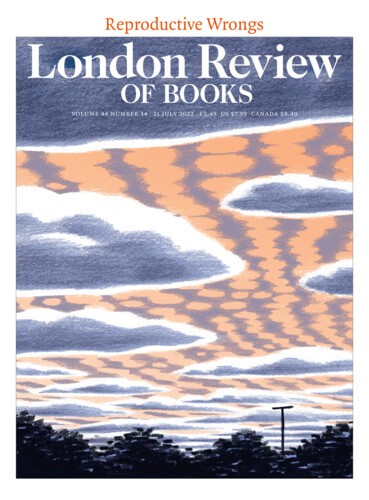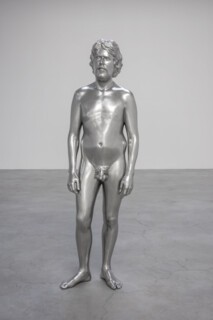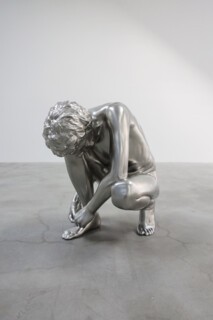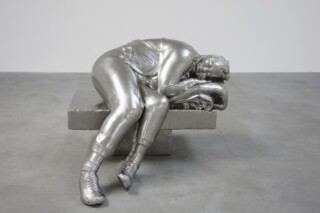Charles Ray’s life-sized Young Man, machine-milled in 2012 from a solid stainless-steel block, is meant, Ray says, ‘to move forwards and backwards in increasingly irrelevant time’. The phrase is less opaque than it seems. His ambition was to make a kouros, but one modelled on the body of a long-time Los Angeles friend. Returning to the clear shapes of Archaic Greek sculpture with the aim of closing the gap between ‘ancient methods of representation’ and the ‘embodiment of the perception of social space-time’ – ‘social space-time’ being a term for what art historians might less interestingly call social context – was no small ambition. On the one hand there are the pure geometries of antique form; on the other, the soft slackness of a slouching body, presented in a way that allows the viewer ‘to become intimate with the relationship of details that are events on the surface of the sculpture’. Ray orchestrates his work so that details become happenings – occurrences – as we look.
To take in the event-filled surface of Young Man, its details and contours, is to begin to grasp what was at stake in its conception and execution. Execution altered conception. Ray discovered that the intimacy he wished to create was frustrated by his decision to produce the sculpture in stainless steel – which required an industrial-grade machine. The result was ‘a work that I feel I didn’t make, but that somehow made itself’. The notion of a self-making sculpture seems all the more relevant when we learn that Young Man is the subject of a photographic portfolio conceived in 2013 by the graphic designer Silvia Gaspardo Moro. Taking up the idea of making and self-making, the portfolio compresses the figure into a set of eight black and white photographs, each showing a distinct section of the sculpted body, seen front and back. When the piece is laid out so that each photograph touches its neighbour, it realises a quite different notion of sculpture: Young Man ironed flat.
Ray was born in Chicago in 1953 and moved to California in 1981. His process is singular; he uses both amateur and professional models, often working with the aid of computer-driven machines, and usually produces at life size or larger. The results seem both traditional (models are sought and posed, clay studies are made in multiple sizes) and cutting-edge (digital scans, 3D visualisations), yet the works are distinctly sculptures in the familiar sense of the term. A number of them were on display at the recent exhibitions of his work at the Centre Pompidou and the Pinault Collection, the polished steel shining bright.
Six years after completing Young Man, Ray recalled the evolution of the piece: ‘As I worked away on this sculpture, time passed. I saw surface as an abstract manifold, a kind of armature of the soul, a toe in syncopation with a hip, a machined surface rather than a carved or cast form.’ The first point is straightforward: producing the sculpture took time. The last point, too, is self-evident: its surface was machine-made. Between these two propositions, Ray’s thinking seems elliptical. This is my attempt at an interpretation: as time passed in the studio and the final machine-made character of the work became clearer, Ray realised that the surface he was making was a set of directions and deformations in space, and as such, a purely topological reality. Maybe a surface of this kind, he thinks, might express a figure’s inner state. Some such idea surely underpins the phrase ‘armature of the soul’.
The idea is arresting. It is also quite different from saying that the surface of Young Man is somehow immaterial or abstract. How can it be, when it remains ‘a toe in syncopation with a hip’? Ray is closely attuned to relations within the body, and perhaps the sheer diversity of his models over the last decade has helped him find the ‘syncopation’ he is after. His works have been increasingly seized by the multiplicity, the sheer complexity, of form in space. They seem to capture the moment before our perception fixes, before we recognise a form for what it represents: a torso, a body, a woman or man. This is what looking at sculpture demands: to see something three dimensionally is also, explicitly, to see it over time. Ray’s sculptures seem to assemble and disassemble before our eyes. Mathematicians are often fascinated by the rules, the complex constraints, that govern a surface as it deforms without breaking – stretching, twisting, crumpling. Maybe all sculptors worthy of the name have had such interests, dreaming of a precise science of compactness and connectedness. But Ray sees it far more clearly than most.
Not all sculptors who work in stainless steel make such concerted use of the brilliant light effects inherent in its surface. Only David Smith has pursued them as diligently as Ray. The two men share a commitment to contingency as well as a medium: not just steel (itself an alloy of iron), but stainless steel in particular, another alloy, first produced in the early 20th century by adding chromium to ‘exceedingly mild steel’. The idea of steel’s mildness is seductive. It invites us to notice the interplay of slip-sliding surfaces and sensual shapes in Ray’s work. Both qualities – shape and surface – seem to operate between two and three dimensions; these continuously curving surfaces aren’t (and never will be) flat. On the contrary, they throw the distinction between dimensions into doubt. It seems right that this complexity of contour is a defining feature of Ray’s metallic surfaces, and that it allows for so many other effects. His steel sculptures spark with light, but they also welcome ambient colour. Viewers catch glimpses of their own reflection on the kaleidoscopic surface, reflections that figure prominently among the ‘accidental’ effects Ray works hard to bring off.
Alongside stainless steel, concrete and paper are currently his preferred media. Respectively ponderous and fragile, both concrete and paper reinforce the degree to which the steel sculptures – Shoe Tie and Sleeping Woman (both 2012), for example, or Horse and Rider (2014) – revel in effects owed to their medium, including its transfixing capacity to shine. Look again at Young Man. The surface finish converts the body’s curves (across the buttocks, for example, or under the arms) into a familiar type, despite or perhaps because of his nudity: a well-fed figure of the corporate office, the golf course, the air-conditioned mall – a little plump, a little lazy. In this context, shininess seems peculiarly American, an effect that carries negative, maybe even dangerous, connotations. At times it looks pristine, and therefore chilling, while elsewhere it looks like bling. There is a counter-movement in Ray, which means that shine is varied, even individually inflected, to amplify our sense of the subject: in other words, shine can help to characterise exactly who or what is portrayed. His characters have mastered their parts.
In 2015 Ray created Silver, a life-size silver sculpture of a German Shepherd. Why this material instead of stainless steel? One reason – and I say this tentatively – may be that the softer glow of silver suggests something more noble, more ancient, than the steel Ray uses for human animals. If so, this is further support for the notion that shine can express something of the subject’s character. Yet in other instances, it lets the surrounding world into the sculpture, inflecting the body it shows. Shining and mirroring, in other words, can sometimes be the same thing. A photograph taken in Ray’s studio captures a bright red reflection in the curls of Reclining Woman (2018), his most voluptuous work. The effect was accidental, which was exactly what Ray intended. His stainless-steel works love the light. And so much the better if in the process a lipstick-red reflection briefly enhances the eroticism of the female nude.
From here, it is a short step back to the diffuseness of shine that characterises the surface of Young Man. How much softer could a solid steel slacker look? The result is a sculptural presence that summons something like the dialectical inverse of American machismo: the ungainly body, the laid-back way of being male. Let’s not forget that in 2012, when Young Man was under production, Donald Trump decided not to throw his hat in the presidential ring. Four years later, he ran and won.
Coincidence, of course. Yet it is no accident that Ray’s cast of characters is so deeply rooted in American life: a buxom nude; a beloved pet; a flaccid young man; a homeless woman seen sleeping at a busy LA intersection, her bed a concrete bench. His description of that experience concerns many things, class and race among them, but it also confirms what we see, that the surface of this sculpture seeks to depict the beauty of the woman’s peaceful pose and ‘angelic’ face. As an Angeleno – an American – Ray was far from oblivious to the social realities of homelessness. As a sculptor, however, he saw the ‘weight’ of her sleep, the ‘soft focus’ of her face, and thought hard about how both should be ‘allowed to come up through her gesture, the structure of her body, and out across the layer of her clothing’.
With this image we return to Ray’s surfaces and the difficulty posed by their special effects. Perhaps their purpose is to question where we stand vis-à-vis our own flickering screens and shiny temptations. Are we inside the world Ray conjures? Outside? Or as Nietzsche might say, are we too ‘entranced’ to ask? It is easy to imagine Young Man existing in the frozen nowhere evoked in this passage from The Birth of Tragedy: ‘The intense clarity of the image … seemed to hide as much as it revealed; and while it seemed to invite us to pierce the veil and examine the mystery behind it, its luminous concreteness nevertheless held the eye entranced and kept it from probing deeper.’ To follow Nietzsche is to recognise in Ray’s shine the capacity to evoke – or embody – our present-day trance.
Send Letters To:
The Editor
London Review of Books,
28 Little Russell Street
London, WC1A 2HN
letters@lrb.co.uk
Please include name, address, and a telephone number.




